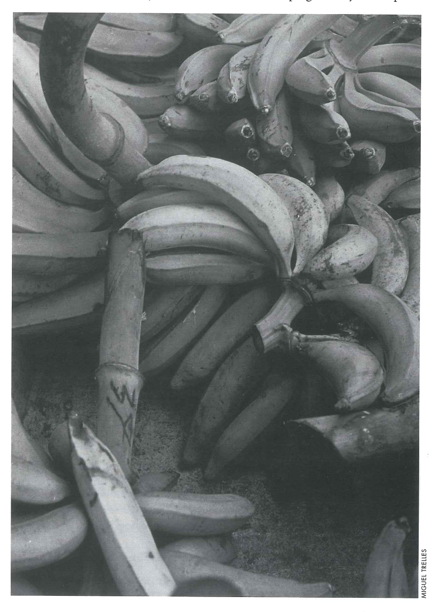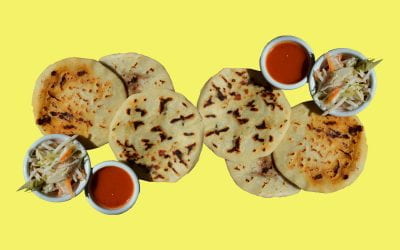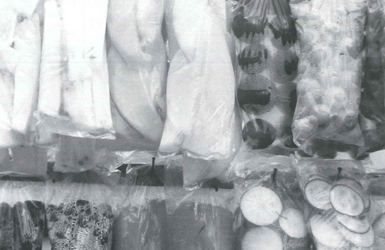From Big to Small, Toxic to Green
New Strategies to Grow Food in Cuba
 Agricultural policy in Cuba has not lacked in audacity. From the wide-sweeping land reforms of 1959 and 1962, to the disastrous drive for a 10 million ton sugar harvest in 1970, to the banning of all farmers markets in 1986, policy changes tend to be grandiose. Over the past ten years agriculture policy and practices have taken another dramatic turn—this time emphasizing food production. By re-opening farmers markets, decentralizing production and giving birth to ecological agriculture, the state has let go of old practices and ushered in new thinking. In doing so, Cuba, which occupies 40% of the land mass of the entire Caribbean, offers major lessons on how a developing country can respond to crisis—on its own terms.
Agricultural policy in Cuba has not lacked in audacity. From the wide-sweeping land reforms of 1959 and 1962, to the disastrous drive for a 10 million ton sugar harvest in 1970, to the banning of all farmers markets in 1986, policy changes tend to be grandiose. Over the past ten years agriculture policy and practices have taken another dramatic turn—this time emphasizing food production. By re-opening farmers markets, decentralizing production and giving birth to ecological agriculture, the state has let go of old practices and ushered in new thinking. In doing so, Cuba, which occupies 40% of the land mass of the entire Caribbean, offers major lessons on how a developing country can respond to crisis—on its own terms.
Through the 1900s Cuban agriculture largely was defined by sugar. Under the Castro government, as long as sugar could be traded to the Soviets and eastern Bloc nations in exchange for cheap oil, the objective was to produce as much sugar as possible no matter the ineffeciencies or environmental cost. The high input, highly mechanized model was “sustainable” only in the narrow sense that the sugar for oil deal sustained its ineffeciency. Cuban agriculture was a toxic, energy-devouring, land-degradating machine. Annually Cuba imported 1.3 million tons of chemical fertilizers, 17,000 tons of herbicides and 10,000 tons of pesticides. By 1989 Cuban farms were using twice the amount of fertilizers as US farms used, with proportionally three times the amount of land under irrigation and with comparable rates of mechanization.
A decade ago, a deep economic crisis swept rural Cuba like a level-five hurricane. The collapse of the Soviet Union and the socialist bloc in eastern Europe caused Cuba to lose 80% of its imports. Farmers had no fuel for the tractors, no fertilizers or pesticides for the fields and no spare parts for the pumps. Agricultural production—and almost everything else—ground practically to a halt. The loss of foreign exchange meant that Cuba could not import the basic food stuffs to provide sometimes even the minimum for its population. The government could no longer provide enough food for the people. Cuba was on the border of total collapse.
With literally no other options—little international aid and foreign investment, insufficient food imports, scarce domestic capital—Cuban policy makers and Cuban farmers turned agriculture upside down in order to produce food for the population. “The only ideological battle,” reads a sign hanging over an organic garden, “is to produce more food.” The words, significantly, are attributed to Raul Castro, the Minister of Armed Forces and a known ideologue. Recognizing that large state farms do not work, in 1993 the government broke up most of them and turned over 40% of the country’s arable land to a new kind of farmers cooperative (known as Basic Units of Cooperative Production ? UBPC). In 1994 the government re-opened farmers markets which use unregulated prices, an action once considered an anathema to centralized planning. And perhaps the most surprising, the Ministry of Agriculture and farmers throughout Cuba have turned to small scale, low input food production techniques which stand in a marked contrast to the high input model of the 1970s and 1980s.
Today the situation has changed dramatically. Agricultural markets are filled with produce and bustling with vendors and buyers. Farmers have responded to strong market incentives and stepped up production. The UBPCs are more efficient than the state farms and have drastically reduced state subsidies for agriculture. Garden plots in the cities now produce half of all the vegetables in the country. And perhaps unprecedented in Latin America and the Caribbean, urban people are moving back to the farms as a reverse migration flow.
The production figures have been fairly impressive, particularly given the obstacles (including the hardening of US sanctions against Cuba in 1993 and again in 1995). The per capital daily caloric intake has climbed 33% to 2473 kilocalories over the past five years after dropping from 2908 to 1863 in the previous five years (2500 is minimum recommended). According to the FAO figures:
– production of tubers and plantains more than tripled from 1994-1999.
– vegetable production doubled from 1994 to 1998 and then doubled again in 1999;
– potato production increased from 188,000 metric tons in 1994 to 330,000 in 1998;
Unfortunately the recovery has not been across the board. Animal-sourced protein production remain close to the depressed 1994 levels and considerably less than levels of production in the 1980s.
The changes in agricultural policy in Cuba offer particular insights to other developing countries. Not only has production increased, but also the restructuring of the agricultural system occurred without social dislocations—small farmers have not lost their land or livelihood and working classes have gained better access to food (albeit at higher prices). That scenario is highly attractive to Latin America and the Caribbean countries where restructuring has caused enormous distress to small producers. Of the reforms most “transferable,” the ecological practices merit much greater scrutiny.
Sustainable development practices were initially resisted by the Minstry of Agriculture. One Cuban PhD in agriculture saw the practices as “a return to the oxen and plows of the Middle Ages;? others perhaps perceived a threat to the control of the bureaucracy. That has now changed. “I don’t believe many people know how big organic farming in Cuba really is,” declared Juan Jose Leon Vega, director of international relations at the Ministry of Agriculture. He estimated 3.7 million acres of the 6.2 million acres of non-sugar farmland are organic. Cuba presently importing 1/6 of the fertilizers and even less of chemical herbicides and pesticides compared to the pre 1989 Soviet era.
Key to ecological agriculture is diversification—not only in markets, land tenure and types of producers, but in production itself. According to Roberto Caballeros, an agricultural specialist with the Institute Dimitrova, there has been a convergence between the economic necessities to reduce the scale of agriculture and the environmental suitability of smaller scale, diversified agriculture. “The tropical climate of an island like Cuba,” he says, “is inherently unstable and on large scale model , the farmer cannot react in time to changes in climate.” By planting multiple crops, rotating the crops, integrating animals and agriculture, many farmers have adapted to the new circumstances. They are more responsive to the market, are less susceptible to major losses, make better use of their resources and engage in more environmentally-sound practices.
While before the economic crisis, most cooperatives and state farms were dedicated exclusively to the production of a single crop, today nearly all farms produce food alongside their cash crop. It is not unusual for a cooperative, like “El Vaquerito” in Moron, Ciego de Avila, to earn more from its sideline of “auto-consumo” than from its principal production of coffee or sugar or cattle. Jorge Luis Hernández, the president of El Vaquerito said, “Whoever holds onto mono-culture will sink. The key is diversification.” Without the ag inputs, the sugar yields are half of what the yields used to be in the 1980s, yet the cooperative continues to make a profit because of diversification. In addition to sugar cane, the cooperative plants 65 acres of fruits and vegetables and tubers, tends 5000 coffee trees and 1000 cacao trees, and raises 400 head of cattle and 150 pigs. The make their own animal feed out of their honey, grains, their cultivated fish and waste products of the sugar. “We’ve been able to keep the boat afloat,” remarked Hernández after seven years at the helm of the cooperative.
Urban agriculture may be the crown jewel of Cuba’s drive towards sustainable and ecological practices. What began as an ad hoc localized response to crisis has evolved into a highly developed and widespread experiment in urban farming. Today half of the fresh produce consumed by two million Havana residents is grown by “non-traditional urban producers” in abandoned lots and green spaces wedged into the crowded topography of the city.
In 1992 in the city of Holguin unemployed state workers began a gardening plot as a survival response. The group counted on resources, tools or specialized knowledge. Since fertilizers and chemical inputs were unavailable, by default the growers turned to organic methods: composting, weeding and manual defense against insects. The movement quickly spread. Though individual backyard plots (as well as chickens and an occasional pig) were part of the movement, what really flourished were semi-organized horticulture groups based on shared values: a self-help approach; sharing produce among the members and with vulnerable groups in schools, clinics and seniors centers; and selling excess produce in the neighborhood. In less than a decade, Cuban urban agriculture arose from abandoned lots to become the largest urban agriculture movement in the Americas.
Recognizing the potential of urban agriculture, in 1994 the government created an urban department of the Ministry of Agriculture. Instead of imposing its authority on this nascent, diverse and admittedly chaotic movement, the Urban Agriculture department wisely has looked to promote, support and “regularize” the practices, for example, by formalizing the growers “claim to community lots and legalizing the growers” right to sell their produce. Through Resolution 527/97 urban dwellers can receive up to one third of an acre for a personal lot in the periphery of the major cities. Through December 1999 more than 190,000 persons had received small lots.
The production from urban agriculture is nothing short of phenomenal. As the accompanying chart indicates, production levels of vegetables have doubled or tripled every year since 1994. Urban gardens produce about 60% of all the vegetables consumed in Cuba (1998 figures). Without including figures for the small gardens and individual farms, urban agriculture alone provided 215 grams of vegetables per day per person throughout Cuba—more than 70% of the grams recommended by the U.N. FAO. The plan for year 2000 calls for urban agriculture to reach 100% of the FAO recommendation.
Though some have disparaged urban agriculture—seen as running counter to modernization and urban progress—in truth, urban agriculture has had an extraordinarily high social impact. The Oxfam-sponsored organopónico in Diezmero, San Miguel del Padron converted a garbage dump into a center for community activity, an experience which has been replicated throughout Cuba as neighbors work side-by-side in the gardens. People have been able to partially resolve one of their most pressing problems through their own efforts. “We don’t have to wait for a paternalistic state to do things for us. We can do it for ourselves,” said a retired schoolteacher in the urban garden in Alamar. More than 28,000 retired people, nearly 20,000 women and 20,000 young people are involved in productive, healthy and remunerative activities.
Clearly, great challenges remain for agriculture in Cuba. With 400,000 employed in the sugar industry and with sugar still the country’s leading export, odss favor that the country will stay wedded to sugar production—despite the disenheartening prospects over the long term. Many farmers, too, complain about intervention by the state in determining what they will produce and how they will sell. Also, while food is more abundant, consumers have been hit hard by high prices in the market.
Despite the problems still to be faced, Cuba has met the food crisis by moving from statist to private, from large to small, from toxic to green. There are great lessons in this story, for those who think Cuba will never change and for those who believe developing countries can never hope to feed their people. Diversification and urban agriculture are only two of the strategies that may be applicable to other contexts. For the skeptics of ecological agriculture, I recommend the words of one Cuban farmer who told me, “We hear with our eyes.” He wanted to see results before listening to advice on changing techniques. The changes in Cuba and the results that they have produced will allow anyone to “hear with their eyes.”
Spring/Summer 2001
Minor Sinclair, of Oxfam America, lived in Cuba for four years as an Oxfam representative before joining Oxfam America. This article is adapted from a forthcoming Oxfam report “An End to the Crisis? Food and Farmers in Cuba,” by Minor Sinclair and Martha Thompson.
Related Articles
Salvadoran Pupusas
There are different brands of tortilla flour to make the dough. MASECA, which can be found in most large supermarkets in the international section, is one of them but there are others. Follow…
Salpicón Nicaragüense
Nicaraguan salpicón is one of the defining dishes of present-day Nicaraguan cuisine and yet it is unlike anything else that goes by the name of salpicón. Rather, it is an entire menu revolving…
The Lonely Griller
As “a visitor whose days were numbered” in Buenos Aires, Argentina, he tossed aside dietary restrictions to experience the enormous variety of meat dishes, cuts of meat he hadn’t seen…



